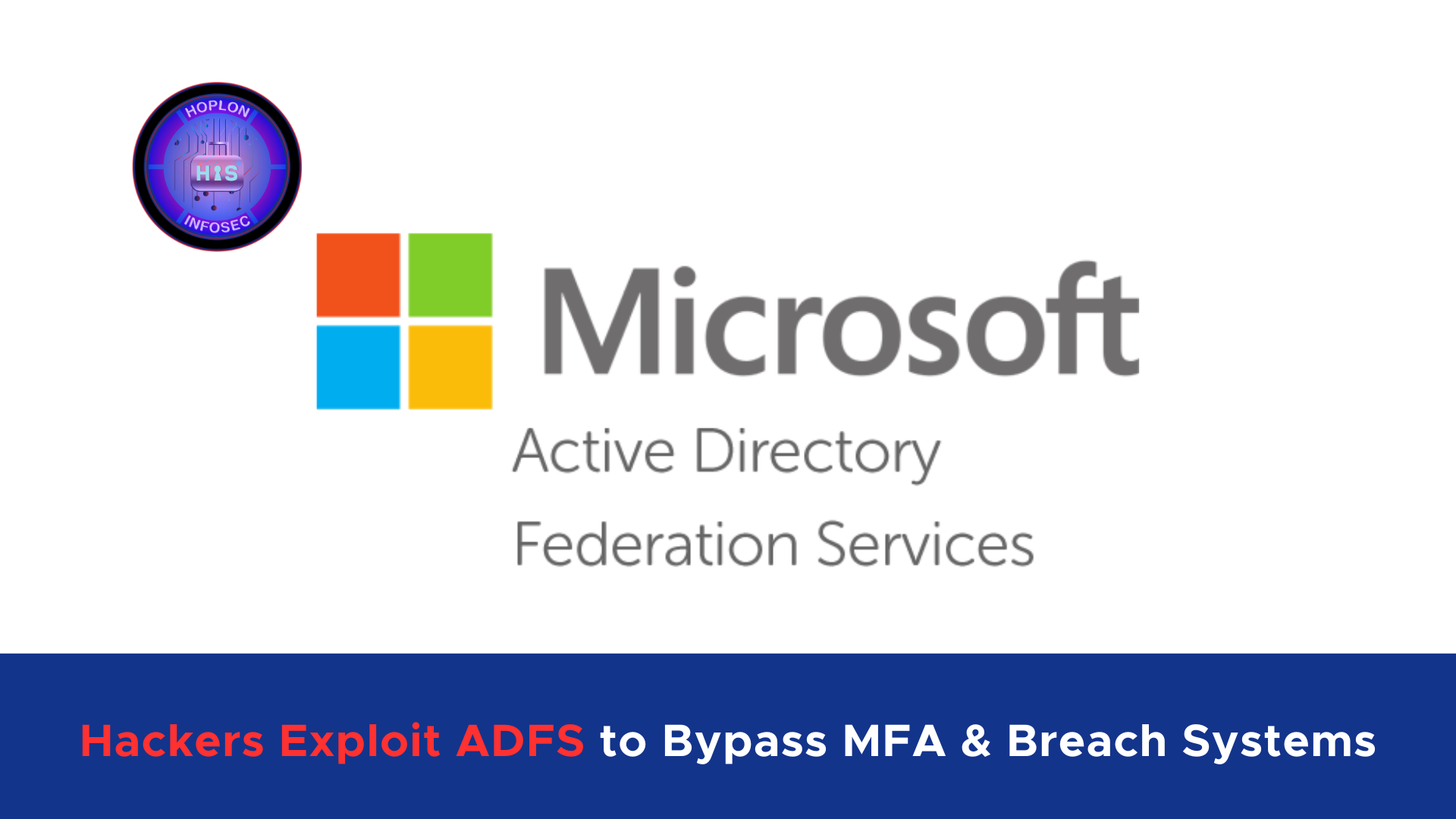Do you know How Hackers Exploit ADFS to Bypass MFA & Breach Systems? Organizations across various industries are facing a new wave of cyber threats. A sophisticated phishing campaign is now targeting enterprises that rely on Microsoft’s Active Directory Federation Services (ADFS). Although designed to streamline authentication across multiple applications, this single sign-on (SSO) solution has unfortunately become an attractive target for cybercriminals. This post will explore how the attack works, discuss the technical nuances behind these exploits, and offer actionable advice on safeguarding your organization against similar threats.
Introduction to ADFS and Its Role in Modern Authentication
Microsoft’s ADFS is a critical component for organizations that require secure access to multiple systems and applications using a single set of credentials. By acting as an identity provider (IdP), ADFS facilitates trust relationships between different applications, enabling users to authenticate seamlessly across various platforms. This centralized authentication mechanism reduces the complexities of managing multiple logins while maintaining a robust security posture.
However, the characteristics that make ADFS an efficient tool for streamlining user authentication can also render it vulnerable to targeted attacks. Cybercriminals increasingly employ social engineering tactics and technical exploits to compromise ADFS environments. When successful, such attacks allow unauthorized access to an organization’s entire network, bypassing critical multi-factor authentication (MFA) defenses.
How Hackers Exploit ADFS to Bypass MFA & Breach Systems

The Role of Social Engineering
Social engineering remains one of the most effective methods for attackers to compromise security. In this particular campaign, cybercriminals begin by sending phishing emails that appear to originate from trusted sources, often mimicking an organization’s IT department. These emails are crafted urgently, citing imminent security updates or critical policy changes. The urgency is designed to lower the recipient’s guard, prompting them to take immediate action without verifying the authenticity of the request.
Deceptive ADFS Login Portals
Once the phishing email is delivered, recipients receive a link leading to a fraudulent ADFS login page. This fake portal is meticulously designed to mimic the legitimate ADFS login interface. Attackers incorporate branding elements such as logos, color schemes, and layout designs nearly identical to the organization’s authentic website. The result is a login page that is so convincing that many users inadvertently enter their credentials, including MFA codes.
The URLs associated with these phishing sites are also manipulated using obfuscation techniques. They often mimic legitimate ADFS structures, making detecting deception difficult for automated link verification tools and experienced users. This combination of social engineering and technical obfuscation creates a highly effective lure for unsuspecting victims.
Real-Time Account Takeovers
After the user enters their credentials and MFA details into the spoofed login portal, attackers capture the primary credentials (username and password) and the secondary authentication factors (such as one-time passcodes or push notifications). What makes this attack even more dangerous is the subsequent redirection of victims to the legitimate ADFS portal. This seamless transition minimizes any immediate suspicion, as the user is unaware that their credentials have been compromised. Meanwhile, attackers can execute account takeovers in real time, gaining unauthorized access to critical systems within the organization.
Technical Exploitation Techniques

Credential Harvesting Through Centralized Authentication
While beneficial for user convenience, ADFS’s centralized authentication model presents a significant risk. Attackers can access multiple systems and applications by compromising a single user account. This phenomenon, known as lateral movement, allows cybercriminals to expand their reach within an organization’s network once initial access is gained.
Credential harvesting is a common outcome of this phishing campaign. Attackers are particularly adept at exploiting the trust placed in centralized authentication systems. By targeting ADFS, they can collect valuable login credentials as the gateway to more extensive network infiltration.
Multi-Factor Authentication (MFA) Bypass
One key defense against unauthorized access is MFA, which requires users to provide an additional verification form beyond a simple password. Despite this safeguard, attackers have devised methods to capture secondary authentication factors. This campaign’s specialized phishing templates are tailored to mimic various MFA setups, such as Microsoft Authenticator or SMS-based verification. Attackers effectively neutralize one of the most robust security layers by tricking users into inputting their MFA codes on a fraudulent portal.
Legacy Protocol Vulnerabilities
The reliance on legacy protocols in ADFS can be another vector for exploitation. Older protocols may lack the enhanced security measures in more modern authentication frameworks, making them easier targets for skilled attackers. Cybercriminals leverage these vulnerabilities to create convincing spoofed interfaces and exploit the inherent weaknesses of outdated security practices.
The Impact on Organizations
Widespread Organizational Impact
The consequences of this sophisticated phishing campaign are severe. By bypassing MFA, attackers can gain complete access to corporate networks, enabling them to execute a range of malicious activities. Once inside, cybercriminals can launch lateral phishing campaigns to target additional employees, exfiltrate sensitive data, and even conduct financially motivated attacks such as ransomware deployments or fraudulent transactions.
According to recent reports, over 150 organizations spanning various sectors—including education, healthcare, government, and technology—have been affected by this attack. Educational institutions have borne the brunt of these attacks, accounting for over 50% of the incidents. The high volume of users in these institutions and reliance on legacy systems make them particularly susceptible to such sophisticated phishing attempts.
Long-Term Repercussions
Beyond immediate financial losses or data breaches, successful attacks on ADFS environments can have long-term repercussions. These include loss of trust among customers and partners, increased scrutiny from regulatory bodies, and a significant financial burden due to the costs associated with remediation, legal proceedings, and potential fines. The reputational damage inflicted by such breaches can be far-reaching, affecting an organization’s ability to attract and retain business.
Mitigation Strategies and Best Practices
Given the evolving nature of cyber threats, organizations must adopt a multi-layered approach to cybersecurity. Here are some recommended strategies to mitigate the risks associated with phishing campaigns targeting ADFS:
Modernizing Security Platforms
One of the most effective long-term strategies is to modernize the security infrastructure. Moving away from legacy systems and protocols towards modern security platforms can significantly reduce vulnerabilities. Implementing solutions designed with Zero Trust Architecture ensures that every access request is continuously verified, regardless of origin. Zero Trust models operate on the principle of “never trust, always verify,” which can help minimize the risk of unauthorized access even if a phishing attack is successful.
Strengthening Multi-Factor Authentication
Although MFA has been bypassed in this phishing campaign, it remains an essential component of a robust security framework. Organizations should consider enhancing their MFA strategies by incorporating adaptive authentication methods. These methods assess contextual information—such as the user’s location, device, and behavior patterns—to detect anomalies that may indicate fraudulent activity. Additionally, educating users on the importance of MFA and the risks associated with phishing can help reinforce these measures.
Enhancing User Awareness and Training
A critical line of defense against phishing is an informed and vigilant workforce. Regular security training sessions should be conducted to help employees recognize the signs of phishing emails and fraudulent login portals. Simulated phishing exercises can also be an effective tool for assessing and improving user readiness. By staying informed about the latest phishing tactics and the corresponding red flags, employees can serve as an early warning system for potential attacks.
Implementing Robust Email Security Measures
Since the initial entry point for these attacks is often a phishing email, strengthening email security should be a top priority. This can include deploying advanced spam filters, employing machine learning algorithms to detect suspicious content, and using email authentication protocols like SPF, DKIM, and DMARC. These measures can help reduce the likelihood of phishing emails reaching unsuspecting users’ inboxes.
Restricting Login Attempts and Monitoring Account Activity
To mitigate risks further, organizations should implement policies that restrict the number of login attempts from a single IP address or account. Coupling these restrictions with continuous monitoring of account activity can help identify and block suspicious behavior in real-time. Security Information and Event Management (SIEM) systems can play a pivotal role in detecting anomalies and orchestrating rapid incident response.
Regular Security Audits and Penetration Testing
Regular security audits and penetration tests are vital for uncovering vulnerabilities before attackers can exploit them. These assessments can provide valuable insights into potential weaknesses within an organization’s ADFS environment and broader security infrastructure. Organizations can significantly reduce their risk exposure by proactively identifying and addressing these vulnerabilities.
A Closer Look at the Human Element
While technical defenses are crucial, the human element remains a significant factor in cybersecurity. Cybercriminals exploit human psychology through urgency, fear, and trust. Understanding these psychological triggers can help organizations design training programs and develop more effective countermeasures.
The Psychology of Phishing
Phishing emails are designed to play on human emotions. For instance, an email that appears to come from a trusted IT department warning of a security update can create a sense of urgency that leads recipients to act impulsively. Employees can be trained to pause and verify before acting by recognizing these tactics. Organizations should encourage a culture where it is acceptable to question unexpected communications and verify their authenticity through independent channels.
The Importance of Continuous Learning
Cyber threats are constantly evolving, and so should the training provided to employees. Regular updates on the latest phishing techniques, real-world examples of successful attacks, and interactive training modules can help keep security awareness at the forefront of an organization’s culture. Encouraging continuous learning and vigilance can transform employees from potential weak links into active defenders against cyber threats.
Conclusion
The sophisticated phishing campaign targeting Microsoft’s ADFS environment highlights the evolving nature of cyber threats in today’s digital landscape. Cybercriminals can bypass even the most robust security measures, such as MFA, by exploiting technological vulnerabilities and human psychology. The implications of these attacks are far-reaching, affecting organizations across sectors and leading to potentially devastating financial and reputational damage.
To combat these threats, organizations must adopt a multi-layered approach to security, including modernizing legacy systems, strengthening multi-factor authentication, enhancing user training, and implementing robust email security measures. Regular security audits, continuous monitoring, and adherence to a zero-trust security model are essential to building a resilient cybersecurity posture.
Organizations can better protect their critical systems and sensitive data by understanding how these attacks work and proactively addressing vulnerabilities. In an era of sophisticated and relentless cyber threats, staying informed and prepared is not just an option—it’s necessary for survival in the digital age.
In summary, while the allure of convenience offered by centralized authentication systems like ADFS is undeniable, the potential risks associated with these systems are significant. Organizations can turn the tide against sophisticated phishing campaigns and secure their digital futures through modern technology, continuous user education, and vigilant monitoring.




